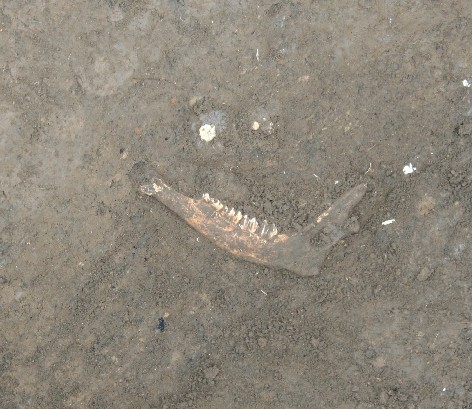
Field Projects: 2005-2011

| CASTALIAN SPRINGS ARCHAEOLOGICAL PROJECT Field Projects: 2005-2011
|
On June 4, we will be conducting an orientation lecture from 8:00 am until 4:30 pm on the MTSU campus.
We will begin on-site preparations on June 5.
Our field class started up today as usual -- a lot of slow and
tedious "prep work" that will set the stage for our discoveries over
the next few weeks. A beautiful day to start work -- warm and sunny,
but not too humid! By 8:00 am, we were moving, unloading, and organizing the half dozen
truckloads of equipment and supplies that will carry us through the next
few weeks. This includes the task of assembling our tent shelters -- a wonderful
experience that I highly recommend for anyone wanting to develop
skills and patience, tolerance and love of your fellow humans! By late afternoon, we had started laying out the first six excavation
units of our 2007 summer field season.
By 8:30 on Wednesday -- we should be stripping the sod and plowzone
from these excavation units and will be well on our way to new discoveries
by the end of the day. Our first efforts this summer are to continue the search for the
eastern palisade wall that once surrounded this ancient town. We are starting our next series of trenches just to the east of the
house investigated in 2006. We'll continue to work to the east over the next several days
-- hoping to cross the trench of the palisade wall.



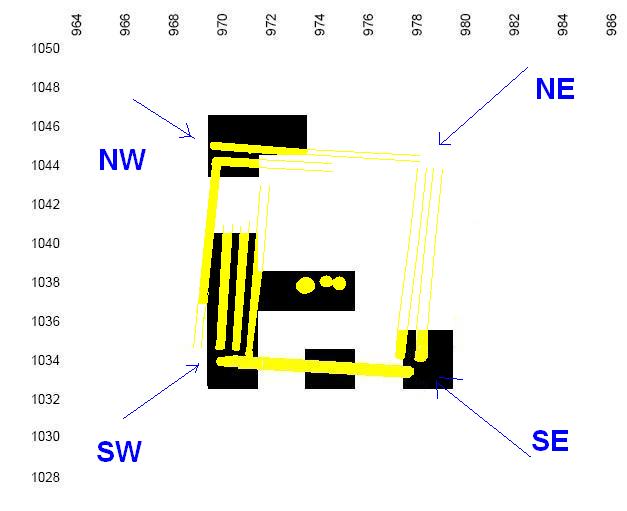
Another beautiful day for fieldwork -- maybe a little on the warmish
side by the end of the day, but the humidity was still low enough to
make the heat tolerable. We started the day completing the layout of our
grid and several excavation units -- below, Jennifer and Rachel hold the
ends of the long reel tapes while other students are placing pin
flags in the background. Here Erik is placing one of the nails at the corner of his team's
excavation unit. By about 8:30, we were stripping the sod from our first set of
excavation units for Summer '07. Our backdirt pile was fairly tiny after the first wheelbarrow was
dumped... But by the end of the day, the hard work of the students was evident
several dozens of wheelbarrow loads later... As the temperature rose above 90 degrees in our open field in the late
afternoon (no matter what the "official temperature" was), I introduced
the students to one of those small pleasures that makes life worthwhile
after a hot day of hard digging -- a gentle spritz of cold water about the
face and head. By the close of the day, we had removed the plowzone (the upper soil
disturbed by years of plowing) from 20 square meters of units. By
mid-morning on Thursday, we should be starting to expose the postholes,
pits, and other features preserved intact from almost 1000 years ago. As
we expected, not a lot of spectacular artifacts were found in the upper
disturbed portion of the site -- but an interesting sharpening stone did
turn up in one of our units. A few hundred years ago, native peoples used
this stone to sharpen their stone axes, chisels, adzes, and other tools
before discarding it. More news tomorrow.

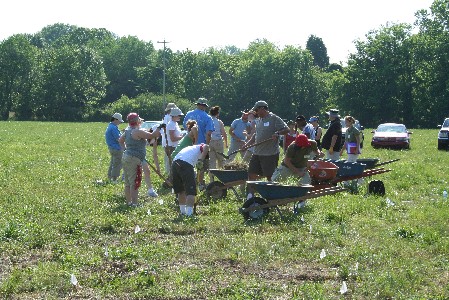
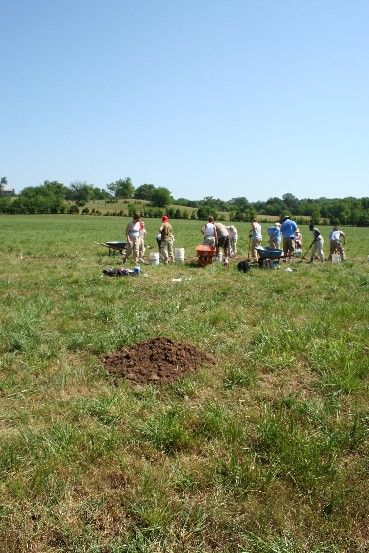
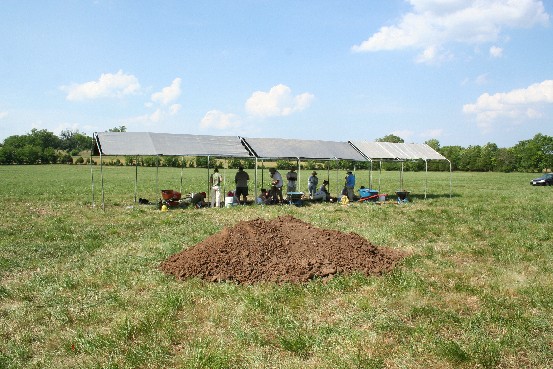

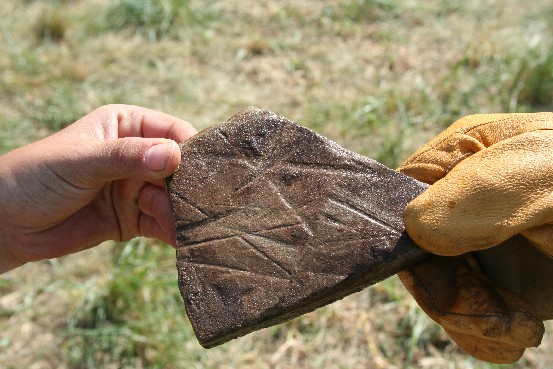
When Emily and I arrived a little before 7:00 this morning, the
crew was already up and about. Well before 8:00, we had the
equipment unloaded and the excavation units uncovered and ready for
excavation. As we prepared to start our work, a flock of geese honked
their way across the field... The crew continued their hard work from yesterday -- despite the rising
heat and humidity throughout the day. As we neared the bottom of the
plowzone today, fragments of animal bone, ceramics, and lithics began to
appear. The plowzone gave us time to practice some needed skills -- measuring
and recording information. As we neared the bottom of the plowzone, a number of possible features
of interest also began to emerge. The drought conditions have made
the soil at the site extremely dry -- difficult to dig and very difficult
for us to find the evidence of ancient postholes, pits, trenches, and
other things of interest.
However, one very obvious large feature appeared in two of our
excavation units -- a large amorphous shaped feature... This feature is almost identical on the "top" to the large post pits
excavated last year just to the west of where we are now working.
These posts were what we thought were the center posts for a wall
trench structure... With the appearance of this new possible set of posts aligned very
closely with those excavated last year, we decided to take a second look
at the southeast corner unit. We weren't satisfied last year that we had
fully investigated all the features in that excavation area -- so Jesse,
Larry, Renee and Teresa spent the afternoon digging back down to the
plastic we placed last year. We'll take a second look here on Friday.
At this point, it seems at least possible that our wall trench
structure from last year may be significantly larger than we thought --
and have a series of central support posts. Similar structures at
Moundville had three central support posts in a row in very large
wall-trench buildings like that shown below (Image courtesy Jim
Knight).
More news tomorrow.







The report for today is a day late because when your field reporter got
home last evening -- he was just too dang tired to put something
together and instead went to bed! Our prep work continued today -- with many excavation units opened to
deeper levels, several other excavation units laid out, sod stripped, and
excavations begun. Our tremendously hard-working crew moved an enormous amount of dirt --
but most of it was plowzone moving down to the levels where we can see
features. Doug Drake -- one of our long time local partners -- dropped by in the
morning with a couple of nice iced-down watermelons to share with the
students. We were also assisted in our digs today by several
experienced volunteers -- Ellis
Durham, Chris Hogan (an alum of our program who was my field assistant for
the MTSU 2003 and 2004 field schools), Lacey Fleming and Brandy Dacus
(recent alums and participants in past field schools at Castalian
Springs). Our friend Lee Myers from Wynnewood also visited today. About 1:00 pm, the rain moved in and we were forced do a rapid
"shut-down" of our excavations and retire to our field house up the road.
After an hour or so, the front passed through and we were able to complete
another couple of hours of work before closing up for the day. Although much important work was done today -- nothing spectacular
to report. More pictures and news are available for Saturday...
Today was the first of our "Volunteer Saturdays" - opportunities
for interested folks to try their hand at real archaeology. Along with about half of our student crew, we had several volunteers --
our thanks to Jennifer Clinton, Brandy Dacus, Lacey Fleming, Ann
Funkhouser, Laura Joseph, Dimesa Lee, Nathan Lesnak, Chris Robbins,
Shannon Smith, and Angela Stroupe! Below, crew member Gwen Boen works
with volunteers Ann Funkhouser and Angela Stroupe at one of the
screens. We were also visited by two of our Research Faculty -- Drs. Shannon
Hodge and Tanya Peres. Below, Dr. Hodge and young son John view the
excavations along with Jesse and Dr. Peres. Although we have few exciting artifacts to report -- we are finding
some rather spectacular and promising evidence of past activites from the
13th century A.D. New units revealed six wall trenches on the north wall of the structure
we started investigating in 2006.
The image below highlights the six trenches -- this amplifies our
information from last year. We knew that this building had been built and
then rebuilt at least four times -- now we know that it was rebuilt at
least five times. Using some educated guesses -- this means that this
particular building existed on the site for probably at least 90 years and
perhaps as many as 200 years. We've now had to update our "plan" from last year to reflect this
rebuilding of the north wall of this structure. Our large pit feature expanded into an enormous rectangularish feature
-- promising to be filled with artifacts that will help us to
understand its function and meaning. And, as always, our student crew continued to practice the skills and
techniques of the archaeologist. Below, Holly makes a successful run up
the growing backdirt pile. Although our first week has been slow in terms of spectacular
discoveries -- next week promises to bring some new insights as we begin
to investigate the features exposed this week. Slowly but surely, our
version of scientific archaeology teases new information and insights from
the earth. More on Monday!





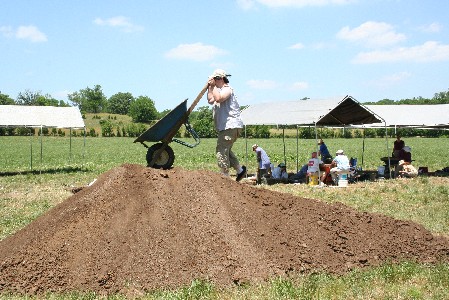
How about a perfect day for archaeology at Castalian Springs? We couldn't have asked for much better -- overcast, a nice breeze, and just about the right temperature to enjoy the work.
When we arrived this morning a little before 7:00, many of our neighbors were out and about near our excavations. This young doe was grazing in the fenceline...

Accompanied a short distance away by four turkeys...

We stopped by the barn briefly to pick up some lumber -- and took a quick photo of our friendly barn swallows (who are doing a SPECTACULAR job of keeping the mosquitoes down!).

After a day or two off, the crew came back refreshed and eager to move some dirt...

Out in the far distance, two of our crews work on "the search for the palisade line" -- not an exciting task, but we all know that finding the "city limits" of this ancient town is one of our primary goals. Here, Jessica, Noriko and Matt work away on one of those units.
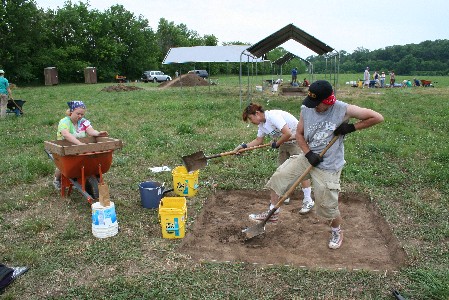
While a bit further out, Erik, Sarah and Lynne do the same.

Back over at the "wall-trench structure," we continued to open additional excavation areas. The first yielded even more rebuilding episodes...
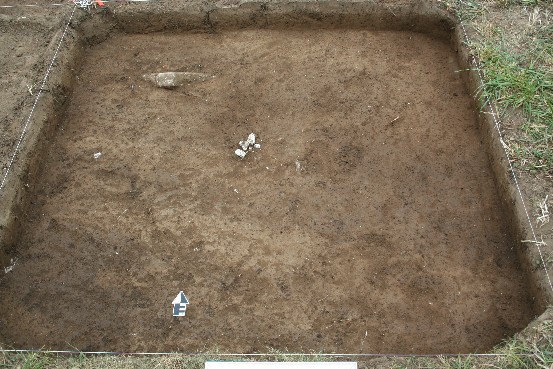
A total of seven in this unit alone
As the day proceeded, we opened other units -- exposing more and more rebuilding episodes...

As the day closed, it appears (at first analysis) that we have 12 building episodes -- meaning perhaps that this structure stood on this spot for 200-300 years.
As we proceed into excavating structures and features, more significant artifacts are turning up -- including a handle from an ancient pot.

Based on our formula, the handle shown above probably dates between A.D. 1275 and 1300.
Four more weeks to go -- the next few days promise to be both exciting and insightful.
More on Tuesday!
Today was a bit warmer than yesterday -- but the humidity wasn't that
high and we had a good breeze, so overall a fairly pleasant day for
digging. The crew continues to move dirt at an awesome pace -- we've already
moved about 15 cubic yards of dirt in only a week. Our real problem is
the drought -- with ten inches or so below normal rainfall, the soil is
bone dry to as much as 25 or 30 centimeters (10-12 inches) below the
ground surface. Not only does this make for unpleasant digging conditions
(imagine shoveling through concrete and you'll be close), it also makes
the subtle differences in soil texture and color almost impossible to
spot. Even when we can see them, they are visible for only a brief time
before the heat and wind dries them out. In order to deal with the situation, we've been forced to start hauling
massive amounts of water to the site frequently to wet down the units.
Today, we hauled about 120 gallons of water and soaked down several of the
excavation areas -- we'll let these soak overnight and then work to
identify and map the features in the morning. Below, Rachel, Travis and Russell hack their way through the
concrete-hard plowzone... Nearby, Jesse, Renee, Teresa and Larry excavated several of the
postholes discovered in one of the units. After excavation, photographs
of the excavated features were made. Forty meters to the east, Lynne, Sarah and Erik discovered what appears
to be yet another wall trench for a building -- although it showed up
fairly clearly when initially exposed, it had dried to invisibility a
short while later. During the day, I worked trying to identify some of the features -- the
photo below shows the drought conditions fairly clearly. Although we had
soaked this unit down fairly well yesterday, the upper inch or so was
already dusty dry again by mid-day today. The "moister" looking areas are
where I have scraped off the upper inch or so to get down to the moister
soil -- and identify the outlines of a firepit and large trash pit
(outlined in yellow). A closer view of the firepit is shown below -- the lighter colored
material is ash mixed with charcoal. The bright orange outlining most of
the feature is the result of a hot fire. Hopefully, the water hauled to the site today will assist us in the
morning in identifying the wall trenches, postholes, and pit outlines in
our open units. Most of the crew have shifted over to re-excavating our
units from last year -- we hope to be able to expose a significant portion
of this large wall-trench structure before the end of the class. More on Wednesday!






Another beautiful day at Castalian Springs -- a tad on the warmish
side, but the humidity continued to cooperate and a pleasant breeze
in the afternoon took some of the edge off. While yours truly continued to try to deal with identifying the
features, most of the crew worked on re-excavating six of our units from
last year -- about 258 cubic feet of dirt. At 8:30 this morning, they
were starting the task... By 2:30 pm, the last wheelbarrows of dirt were being removed... While running an errand up at our field house, I startled 15 turkeys
hiding out in the brush along one of the fencelines -- they made a hasty
departure across the north forty. Meanwhile, our massive "hydration" strategy to make the features more
visible worked nicely. Heavily soaked with about 60 gallons of water,
re-trowelled to a fresh surface, and allowed to dry -- the units below
revealed the wall trenches. For the less archaeologically inclined, I've highlighted the 10
trenches below in yellow -- you can compare to the photo above to see if
you can see the faint but very visible outlines of these trenches. The photograph below shows the "new" units on the left and the
re-excavating units from last year on the right. Here is the image edited -- showing the "new" wall trenches in yellow
and the perpendicular wall trenches from last year in blue. We'll be
opening several additional units in the next day or three to connect the
lines in between. With a much larger number of units opened -- we had to expand our
coverage with plastic today. As we open additional units, opening and
closing down each day will get more complex -- with multiple overlapping
sheets of plastic. On Thursday, we will re-excavate the final set of units from last year
on the corner of this building -- and begin excavation of the new wall
trenches. I'll be working to clean up our big pit feature and firepits
for excavation in the next couple of days as well. These features will
undoubtedly reveal some interesting artifacts. More on Thursday!







And yet another beautiful day at Castalian Springs -- the
temperature keeps edging up, but the humidity continues to be low and
the pleasant breezes continue to take most of the edge off. In the early morning, we often run across some of our neighbors on the
property -- it is truly rewarding to see that the purchase of this
property by the State of Tennessee is not only preserving this ancient
Native American town but also providing a safe haven for wildlife. This
morning, we encountered our two bunnies that live next to the
dairy
shed (a nearly daily event). A little before 8:00 am, two of our deer friends were grazing just
north of our excavation area -- below Noriko enjoys watching them. They
came back through the field about 2:30 or so. Today, our excavations continued on the wall-trench structure. We are
now convinced that this building is an incredibly significant part of this
ancient Native American town. It clearly was not just an average
run-of-the-mill house for a family living at the Castalian Springs town
some 800 years ago or so. We are convinced this was a community building
of some kind -- a community center, shrine, or other type of "special
building" that was so important to the citizens of this ancient community
that they built it again and again on the same spot for over 100
years. We began investigating the wall trenches described yesterday --
excavations of the first of ten trenches clearly revealed that these are
trenches for a structure. Having finished re-excavating our units from last year, one of the
trenches on the northwest corner of this structure clearly lines up with
our new trench. And, the limestone wedges from last year and this year
also match up nicely. On the south wall(s) of this structure, we also finished some new
excavations -- revealed yet another wall trench. We also started expanding our investigations around the central support
posts from last year -- directly to the north, we encountered what seems
almost certainly to be yet another large roof support post (last years
are shown in yellow -- the new one is shown in blue). There are a couple of other features in this unit that appear to be
another posthole and perhaps a hearth/firepit. As we proceed, this structure continues to tell us that it is large,
complex and something very very important to this ancient community. Our
work will continue over the next three weeks to expand our understanding
of what this building was and what it meant to the folks that inhabited
this town 800 years ago or so. Our revised plan is shown below -- it will
change daily as we gather more information. More on Friday!





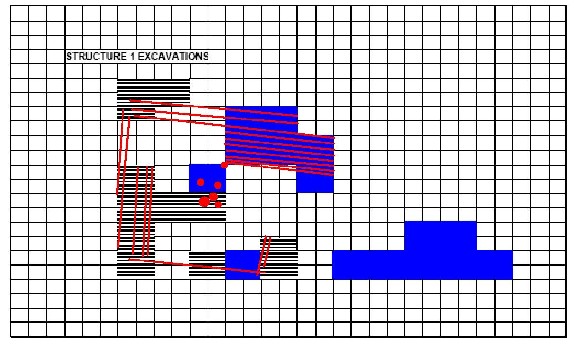
Once again the thermometer peaked out above average for this time of
year -- but it hasn't yet reached the famed Middle Tennessee
temperature=humidity (i.e. 92 degrees and 92 percent humidity), so we've
managed to keep up a solid work pace. Another couple of early morning shots of our deer neighbors... We continued our excavations on the large wall trench structure --
opening several new units, mapping features, and starting feature
excavations. Numerous additional new wall trenches have been exposed on the west
wall and east wall, but weren't ready for photography today. Excavations
of one of the wall trenches on the north (Feature 46) continued --
revealing a series of small widely spaced posts in profile. Student training on surveying and mapping continued today. Here, Emily
instructs Renee on the transit -- while Larry, Matt, Noriko, Jessica, and
Teresa wait their turn. Far out on the western periphery of the site, we laid out some new
excavation units. Although the wall-trench structure will take up much of
our time and energy over the next few weeks, we also want to continue to
develop our understanding of the "big picture" of the site. William
Edward Myer, a Smithsonian archaeologist who excavated at the site in
1892, 1898, and 1916-1917, recorded in his notes that this area was the
"main village area." We presume that Myer noted large amounts of broken
pottery, stone tools, and other items on the surface of the plowed fields
at that time -- leading him to believe this was the main area of
residences. We hope this area will produce a large sample of pottery that
will assist us in determining the age range of the town site. Here, Jesse, Noriko, Teresa, and Renee (kneeling) hold the tapes while
Howie, Larry, Michael, Jessica, and Matt assist. Our current
excavation areas are visible in the distant background. Later in the afternoon, the promise of rain raised everyone's
spirits... Unfortunately, the hard rains went to the north and south of us -- we
got about 15 minutes or so of a shower, but it served mainly to settle the
dust and raise the humidity. Tomorrow is the second of our Saturday "Volunteer Days." We'll hope to
have some interesting artifacts from the "Western Digs" by the end of the
day.





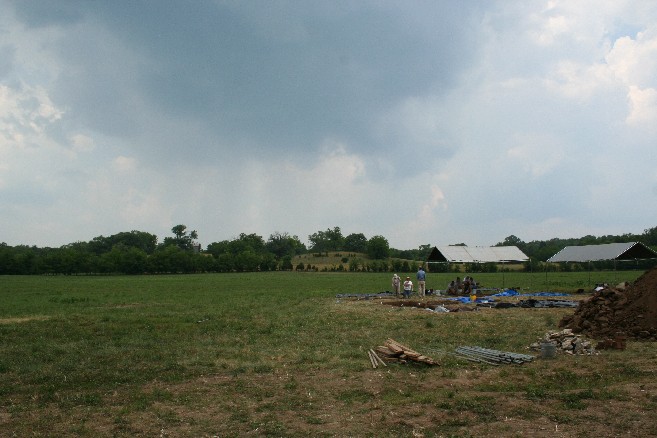
Beating the same drum -- pretty hot today, but again not too humid and
a nice breeze to balance out the high temperature. Unfortunately, we
continue to see the effects of the drought -- our bunny friends have
apparently moved on since the stream branch has dried up next to their
burrow. Trees are wilting and even the weeds aren't looking too good. During my usual early morning trip around the property, we noted three
turkey vultures resting atop the tobacco barn. They are frequently
resting there in the mornings -- and are probably using the barn for
nesting as well. Although often considered with some disgust by modern
Americans, these birds are important contributors to the natural process
of life and death -- and were sacred birds to many Native American
cultures. Their grace and skill in flight is quite amazing -- today, we
caught one of them in the "horaltic pose" with wings spread. Although
debated by vulture specialists, we'll stick with the prevailing notion
that they are drying their wings in preparation for a day of flight. Volunteers Mark McKee and Brandy Dacus worked with Cy Taylor excavating
another part of the south wall trench on our big structure. While Lynne, Rachel, and Sarah continued excavations on the large
trench on the north wall of the structure. Most of our students and volunteers were working a few hundred meters
to the west in our "undiscovered country" (our previous excavation area is
in the far background). Since we have never excavated in this portion of the site before, we
are taking things slow and careful -- each unit is being excavated in
10-cm levels and all of the dirt is being screen for artifacts. Despite
the fact that they were working in plowzone, it is already apparent that
there is a greater density of artifacts in this area -- pieces of stone
tools, small fragments of pottery, and other items. We didn't quite make
it through the 20-cm plowzone today -- but this area holds promise for a
great artifact sample during next week's investigations. Below, students Jesse, Renee, Teresa and Larry consult with field
director Emily Beahm while one of our experienced volunteers -- Ellis
Durham -- works at the screen. At the next unit over, crew chief Jessica Connatser supervises student
Gwen Boen and her parents David and Debbie who came by to volunteer. We have now closed down for a day of rest -- check back on Monday. We
will be starting to excavate many features and artifacts now that we've
set the stage!





When I arrived this morning, it was fairly clear that rain was on the
way, so we adjourned to our field house nearby until about 9:30 am. Two of our field crews adjourned to the far western part of the field
to continue exploring this new part of the site, while the other four
crews continued work on the wall-trench structure. About 10:00 in the morning, we had a fly-over from one of the most
awesome birds ever built - a B-17 Flying Fortress. Thanks to a new telephoto lens I bought over the weekend, I managed to
capture this plane up close and personal... While cross-sectioning one of the wall trenches, we documented the post
holes in profile -- these holes tell us the diameter of the posts that
were used in constructing these buildings and a great deal about the
"above ground architecture" that no longer survives. We continue to open new excavation units exposing the walls of this
ancient building. As the day proceeded, we found what we think are the eastern walls of
the building -- and what appears to be a second wall-trench building to
the south with an interior pit and hearth. By about 3:00 pm, the sky was warning of impending rain... So we shut down our excavations quickly and made it out of the field
before the thundershower hit. We are making great progress on finding the pieces and parts of the
ancient town that once dominated the landscape of Sumner County around
A.D. 1200. Over the next three weeks, we will focus on trying to
understand how these pieces and parts fit together. Tomorrow, we hope will be a wash for our field excavations -- our
friends in the Castalian Springs neighborhood desperately need some rain
to salvage their crops. We'll probably work in the lab most of the day
washing artifacts.

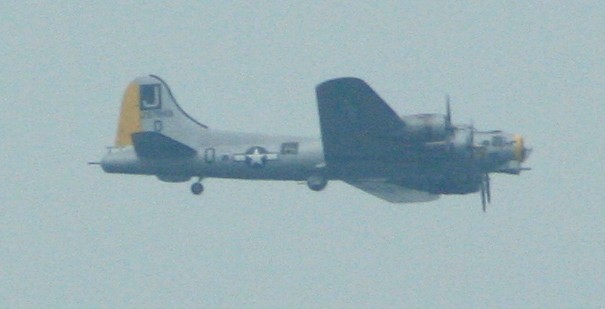





Finally, some relief from the dry conditions with a nice day of rain --
not enough to break the drought perhaps, but at least something! The
showers started by about 7:00 am and set in for an intermittent but solid
rain for much of the morning and early afternoon. When I arrived this morning, I caught a couple of turkeys out enjoying
the showers... In the early morning, we had a lecture at our field house on the
Mississippian site of Averbuch and then adjourned for a tour of
Wynnewood State Historic Site across the highway. Our friend Nettie provided the students with a guided tour of the
house... And our friend Lee gave a demonstration of his skills on the foxhorn
(used backed in the 1800s to let neighborhood folks know that the mail had
arrived at the Post Office)... After lunch, we worked in our field laboratory washing artifacts. Here, Andrea washes a bag of artifacts from the digs... While Jessica, Noriko, Lynne, Gwen, and Ali wash other artifacts... By 4:00 pm, we had washed up a few thousand artifacts -- in the tray
below, fragments of flint, pottery, animal bone, and a few plain old rocks
are cleaned and starting to dry. We'll then inventory and analyze these
materials over the next few weeks. On the way home, I stopped by to check on the excavations -- our
plastic is full of water and ready for some bucket brigades in the
morning. We'll be back on the site tomorrow to continue our excavations.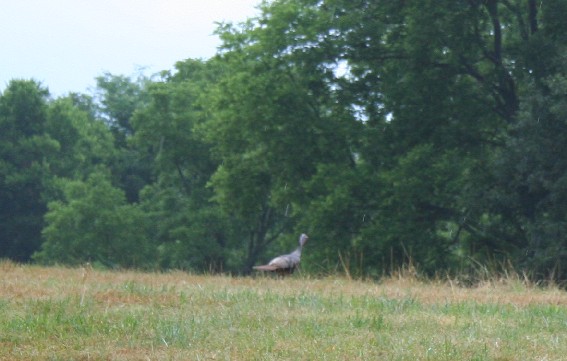



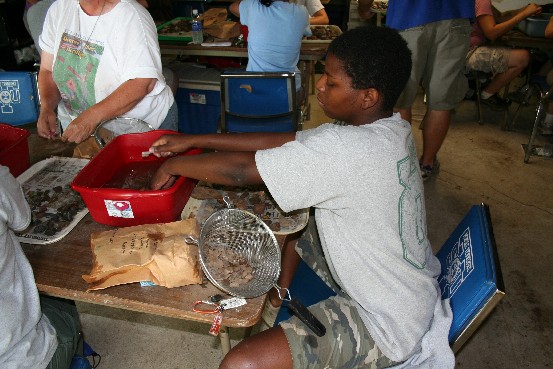



After a welcome day of rain, the first task for Emily and me this
morning was to spread some hay and a few wheelbarrows of dirt in the gate
-- the mud was deep and slick even for my Tahoe loaded down with a few
hundred pounds of equipment. Another task that awaited us was bailing the water from our plastic.
While we have been bemoaning the dry conditions in our units, we couldn't
simply leave them open to the rain yesterday. Too much water and the
excavation areas are too soaked and "slimy" to excavate for a day or two
or three -- just as bad as too dry. So, we cover them up -- and water
them ourselves so that we have control over how much water ends up on our
features. About 800 or so gallons of water had collected on our plastic... Bucket brigades moved the water off to the side fairly quickly --
including the trademark "Erik Porth Water Toss" shown below... Our six student crews continued work diligently on the wall trench
structure and on the west end of the field today... The students are working very hard with few complaints under very
difficult field conditions -- it's been hot and dry, the dirt is hard and
uncooperative. They're a great crew! The real problem at this point is that we need to complete excavating
some of the "features" that we've exposed -- some of the many wall
trenches, pits, and postholes -- before we open any new excavation units.
While I prefer to let the students explore and practice skills in
excavating these types of features -- the conditions on site are making it
difficult to do this. Over the next day or two, I'll have to work
overtime excavating the tops of these features down far enough that the
soil conditions will permit students to "learn by doing" without damaging
the important parts of the site that we're uncovering. Nothing critical
about their skills or desire to learn -- just the fact that the features
are so complex, faint, and dry that they challenge even my considerably
greater experience to follow. As we began to excavate some of the wall trenches today, larger and
more interesting artifacts did begin to appear. Below, Travis shows a
large fragment of fabric impressed pottery and a deer bone recovered from
one of the west wall trenches. Nearby, we started trying to define the edges of the hearth and large
pit... The "hearth" turns out to be an oddly shaped feature filled with
ash, charcoal and pottery fragments -- the sides have been burned to the
consistency of pottery. In order to better understand the pit feature, we are excavating a
"cross-section" of it -- basically cutting it in half starting in the
middle and working our way back. This will help us define the edges of
the feature. Out on the western edge of the field, our two crews reached the bottom
of the plowzone -- and as hoped, started to expose some undisturbed
garbage deposits from a thousand years ago. Large pieces of pottery like
to pot rim with handle shown below... And large fragments of animal bone discarded from meals -- like the
deer leg bone shown below... While the plow has disturbed the upper 8 inches or so -- we are now
beneath that area and the fragments and pieces of daily life from 1000
years ago are being unearthed. Over the next few days, our work will slow down a bit as we try to
figure out the complex set of structures and features we've uncovered. At
this point, our large public building looks something like that shown
below -- about 30 feet on a side. Although the weather has slowed our efforts to learn and understand --
and created some frustration on the part of both professor and students --
we are occasionally reminded of the joys of being outside learning
hands-on rather than in a classroom. Below, a great blue heron flew over
the central mound of this ancient town towards the end of the day.
The secrets and mysteries of Castalian Springs have been preserved for
almost a thousand years -- because it is now a state owned property, it
will be protected for many more years to come. While our work has been
slowed by the drought conditions this year, whatever we don't finish will
be there next week and next year -- and next decade. Undoubtedly many
generations of blue herons have flown across the mound in the past --
many more generations will have the opportunity to fly across students
and researchers teasing the secrets and mysteries from the earth. More news on Thursday!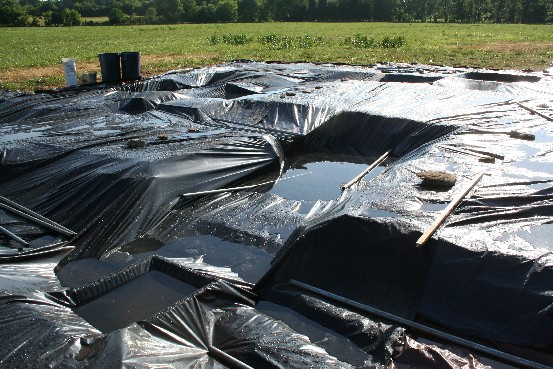

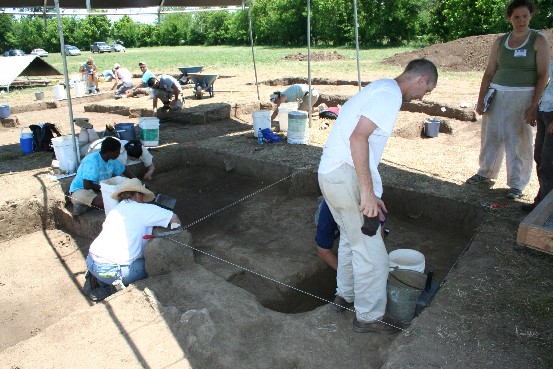





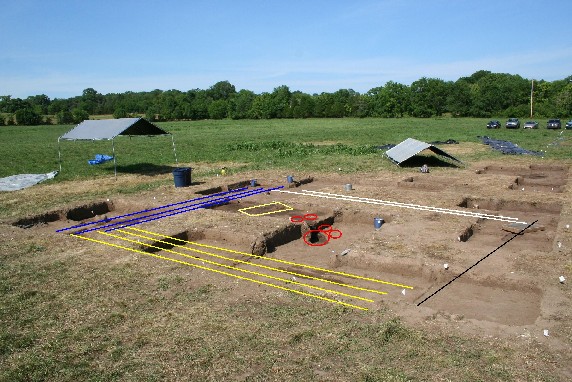

Today, we slowed down a bit to figure out a few things on site. Two of
our six student teams worked in the lab today under the direction of Lynne
Funkhouser (crew chief) and later Dr. Shannon Hodge (Research
Faculty). Two of our other teams contined their work on the far western edge of
the property -- with somewhat unexpected results. Although visible a bit
higher up, at about 25 cm deep (about 10 inches) a large trash-filled
feature appeared with a very linear edge on it. While it is undoubtedly too early to speculate, I'll do so anyway --
this is probably our best candidate for a ditch associated with a palisade
line to date. We'll open another excavation area on Friday to try to
further define the width of this "ditch." Back on the east side of the digs, two crews worked with me to
cross-section the large pit feature. The feature was excavated in
three levels (each about 4 inches each in thickness). The first level was
somewhat amorphous in outline (without clear shape) -- this is because
this upper portion had been slightly disturbed by the plow, rodents, and
other things up near the surface. The fill in this level included a large sample of undecorated pottery,
numerous animal bones, ash, and charcoal. Also, a large piece of a burned
log turned up -- this will be extremely useful for future radiocarbon
dating. By the bottom of Level 2, the edges of the features had become more
defined -- as an oval basin-shaped pit. And finally, we reached the bottom of the feature -- a well defined
oval basin shaped pit. We'll continue to work on this further on
Saturday. While running (well, perhaps walking casually) betwixt and between our
excavation areas on the east and west side of the property, we took some
time to look at the local insects. The little critter below (along with quite a few others) was found
munching on the local milkweed. Commonly known as the Eastern Milkweed
Longhorn Beetle. I've noticed the odd little monsters below several times in the last
few days -- they're munching on horse nettle in this field. They appear
to be the larvae of the Colorado Potato Beetle. Finally, we achieved a little bit of clarity on the many wall trenches
today -- the multiple soakings of the units over the last couple or three
days helped with defining the edges. Students will be working on three of
these trenches on Friday. Today, we closed out with another good soaking of the units --
including filling the excavated portions of the wall trenches with water.
This should soak the adjacent trench fill enough to make it much easier to
"feel" the edges of the trenches as they are excavated. A litte over two weeks to go -- lots to do and lots to discover!



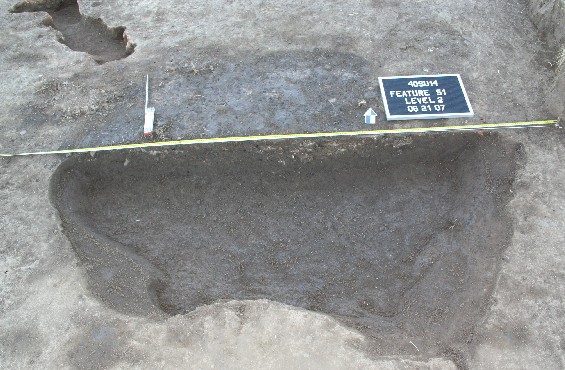




Having worked with our wall trenches at 20 cm below the surface for
several days -- we decided to take all of the units down another five
centimeters or so. At 20 cm we are still in the transition from the
bottom of the plowzone to undisturbed features -- in simple terms, the
tops of the wall trenches are still a bit "blurry." Five centimeters
deeper, we were able to begin seeing the trench outlines much more
clearly. The crew put in 200% today -- taking seven units down five centimeters
on our hottest and most humid day to date. They also shoveled out another
excavation unit on the east wall -- a critical unit for understanding the
overlapping set of wall trenches described below. On the northwest corner of the structure, several of the students
cleaned up and mapped the newly exposed features. Excavations of part of one of the west walls revealed a tiny but
exceptionally well preserved bone bead. As the work proceeded today, it became clear that some of our confusion
over the many wall trenches is because we actually have several partially
overlapping buildings -- some of which have been rebuilt several times.
Here with some of our new interpretations highlighted (different
colors represent probable different buildings)... From another angle... And here also with our new interpretations highlighted... There are a number of other wall trenches present that we haven't quite
figured out yet -- we'll work on re-cleaning the units on Saturday morning
and hope to have some cleaner maps by Monday. A long hot humid day of hard work over -- more news on Saturday!

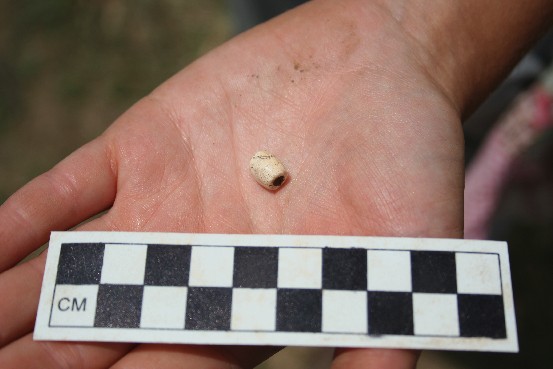




As is my common practice, I took a few minutes to look around the
property on arrival early this morning. We managed to catch an indigo
bunting singing away in the north field... Today was the third of our four "Volunteer Saturdays" for family,
friends, and community members. We had a great turnout for the day that
received the "Hottest and Humidest Day of the Summer Award for 2007." After opening the excavation area, several of us worked on cleaning up
the several units with our hard-to-see wall trenches in them. I cleaned
up
the new excavation unit on our elusive east wall with good results. Finally, we have three (or perhaps four) well defined trenches for the
east wall (shown in yellow -- the very wide one probably represents two
partially overlapping trenches) -- along with a rectangular fireplace
(outlined in blue) intruding into one of the trenches I was assisted by Ellis Durham -- one of our most experienced
volunteers. Ellis has been out many days this summer (and has volunteered
on almost all of our field school projects over the past 10 years). I also had some great help from volunteers Sandy Norby (B.S.
Anthropology 2005 and an alum of our 1999 field school) and friend Karen
Pendley. By the end of the day, we had cleaned up seven units -- ready for
mapping on Monday morning. Nearby, Field Director Emily Beahm directed excavations on the rest of
the large pit feature started earlier this week. Here Emily and Sarah
work on excavating the ash and charcoal deposit at the top of the
feature. While Gwen and Cy carefully screen the soil removed for smaller
artifacts and bits of charcoal. Later in they day, they were assisted by Robert Miller, a volunteer
returning from last year. By the end of the day, they had completed
excavation of the upper zone of the feature -- which appears to represent
a final episode of use during which ash, charcoal, animal bones, pottery
sherds, and other artifacts were dumped in the top of this pit. The
deeper zone is very different and appears to represent gradual
accumulation of clean soil. Several students and volunteers continued work on the northwest corner
wall trenches. Here, Travis and Matt continue excavations of one of the
west wall trenches while Matt's fiancee Tara observes and Rachel works at
the screen. Here Rachel is assisted at the screen by father Lee Bagby -- his first
try at archaeology. Volunteer Jennifer Clinton (alum of our 2006 Castalian Springs Field
School) directed excavations of a new portion of the north wall trench
with help from students Lori Ford and Andrea Patton. They managed to
expose a nice section of posts in this trench segment. In many of the
trenches, the remains of posts or "molds" where the posts decayed are not
visible. Catching and recording this section of postmolds gives us very
critical information on the diameter of the posts, their spacing,
and placement within the trench -- all of which allows us to interpret the
architecture of the building with greater accuracy. The edited photo below highlights five of the six posts discovered in
this trench segment. Far out on the western edge of the field, Jesse, Renee, Teresa and
Larry handled a crowd of family and friends volunteering on the dig. On
the walk over to check on their progress, I noticed a Colorado Potato
beetle munching on the nettles. Here volunteers Sara, Austin, and Vaughn Hamill, Susan Ghorbani,
Elizabeth and Emily Ca~nas, Collin Howster, and Lee Bagby work with
students Renee, Jesse, Teresa and Larry. From another angle, volunteers Clayton Ingalls, Sara, Vaughn and Austin
Hamill, Susan Ghorbani, Carolina and Emily Ca~nas, Lee Bagby, and Collin
Howster work with students Renee, Larry, and Teresa. We appreciate all of the interest and help from the volunteers today --
apologies that my order for 85 degrees and 10 percent humidity didn't come
through! Project directors and students are now off for a welcome day of rest on
Sunday. More news on Monday!












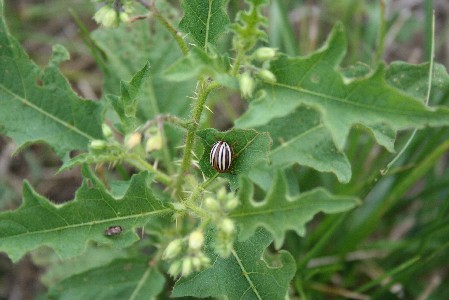


This week begins with cloudy overcast skies -- not an unpleasant thing
for excavations, but with the potential for quick moving thundershowers
and storms virtually every afternoon this week. As our time begins to run
out for this summer, lots of hard work and careful planning are
necessary to ensure that we finish as much as possible. Work continued on our large pit feature (Feature 51). The upper zone
of ash, charcoal and other artifacts does appear to represent a dumping
episode rather than use of the pit for a fire -- there are no signs of
direct burning. We will hope to finish this feature up on Tuesday
morning. Our cleanup work on Friday and Saturday paid off this morning -- after
some careful troweling and inspection of the units, the wall trenches were
much more easily defined. Using some lime green flagging tape, we marked
the clearly identified trenches for photography today. The photograph
below is taken from the northwest corner of the structure looking
towards the southeast. At this point, we have four clearly defined
wall trenches associated with the west wall, four with the north wall,
three (or four) with the east wall, and one on the south wall. Given the consistency of rebuilding episodes, we took a closer look at
the south wall today -- it appears that we overlooked some wall trenches
last year during our excavations. Now that we have a better idea of what
to look for (and how to make them a bit more visible), we identified three
more possible wall trenches on the south wall today (shown below in blue).
We'll clean these units up again on Tuesday and try to confirm these
suspicions. Our excavations of sections of each wall trench continued today (and
will continue throughout the week). We are gathering some very important
information on how the structure was built. On the west wall, we
continued to document how the final version of this structure was
constructed -- the photograph below shows a section of the trench
excavated today. The trench itself is fairly wide -- but the part of the trench holding
the small posts is relatively narrow. As highlighted below, the posts
were placed in a much narrower section of the trench, with hard packed
clay on the outside. In the photo below, the entire width of the trench
is outlined in yellow, with the narrower portion outlined in blue. Out on the far periphery, one of our crews continued examining our new
"ditch" feature. Work is proceeding slowly here -- the feature is filled
with limestone, large fragments of pottery, animal bones, and other
artifacts. We'll continue work in this area on Tuesday. About 1:30 pm or so, the clouds in the distance started to form up in
some ominous patterns. Given the nature of the weather in Middle
Tennessee in June, we can't close up our excavations every time a dark
cloud appears on the horizon or a brief shower passes over. But, we have
to watch the skies continually when potentially dangerous weather
threatens (and listen to my weather radio). After ten years in the fields
of Castalian Springs in June, I have a fairly good handle on whether the
approaching clouds are threatening, how fast they are moving, and whether
we should close up our excavations or not (I understand this is now called
the "Dr. Smith Doppler Weather Radar"). By 2:00 pm, the skies were dark
on the horizon with too much lightning (then about 3-4 miles away) for us
to remain out in the field safely. For the safety of the students -- we
moved to our nearby field lab to wash artifacts. As it turned out, we didn't get any rain until about 3:30 pm -- and
then only a brief shower. The thunderstorms passed a mile or so north of
us. I'll expect to make these same safety calls for the rest of the week
given the forecast. But, there's always work to be done in the lab. We worked on washing
some of the many bags of artifacts already recovered this season. As shown in this newly washed tray of artifacts -- we've recovered
several thousand artifacts already. This tray is filled with fragments of
pottery, stone tools, animal bones, and (yep, you guessed it) some rocks
as well. Now that we've gotten many of our wall trenches defined -- we'll
hopefully be excavating sections of several of those on Tuesday and
throughout the rest of the week.








A hot, humid, and very busy day at our site -- the rain held off until
after our day ended. Early this morning, we noticed a killdeer had set up house in our field
-- she probably has a nest out there somewhere. Our crews worked on several different sets of features today --
labelled in the photograph below A-E: (A) north wall trench near the
northwest corner; (B) the big pit to the east of our wall trench
structure; (C) a newly discovered south wall trench near the southwest
corner; (D) the stone-filled feature near the center of our structure; and
(E) several overlapping wall trenches near the center of the east wall of
our structure. At (A) -- we excavated the postholes within the wall trench... At (B) -- we finished up the major part of Feature 51 -- the big pit.
However, a deeper sub-pit appeared in the bottom (the darker circular
stain near the center of the pit). We'll work on that on Wednesday. During the day, we discovered a wandering visitor -- a Monarch
Butterfly caterpillar. We took it over to the nearby milkweed patch --
it's favorite food. On the south wall -- we continued looking for some of our "missing"
trenches. We think we have found all four of the trenches for the south
wall now. Excavations started on one of them -- below Erik is getting the
trench ready for formal photographs (note the dark posthole stains in the
trench). After cleanup, the postholes showed up nicely. We'll continue excavations on this trench on Wednesday -- and start
work on sections of the other two suspected south wall trenches as
well. At (D) -- we excavated what appeared from the surface to be a posthole
later filled in
the top with rocks. I was a little concerned about this feature from the beginning --
packing a posthole with rocks after the post is filled is not a typical
Native American practice in our region. It is, however, a very typical
historic period Euroamerican practice. Upon excavation, we remain
uncertain about this particular feature -- it does appear to be a
posthole, but it is squared off and flat bottomed. At this point, my
guess is that it might be part of a fenceline from the 19th or 20th
centuries. We'll have to evaluate this one further in the lab and think
about it. At (E), we started exploring the multiple wall trenches for the east
wall. This part of the structure is the most complex and confusing -- at
the end of the day, we think we have figured it out a bit. The four
trenches appear to all overlap on this wall -- we have at least three
lines of postholes (photos on Wednesday!). We did excavate several
interesting items from these trenches today -- including the flint
arrowpoint shown below. On my way out of the site this afternoon, I caught this deer jumping
the fence... More news tomorrow.








One more hot, humid and even busier day at our site -- the rain once
again held off until our day ended. Thanks to the hard work of our student crews today, we managed to
answer many more questions about the large wall-trench structure we've
been investigating. Our crews continued working on several different sets of
features today --
labelled in the photograph below A-E: (A) north wall trench near the
northwest corner; (B) the big pit to the east of our wall trench
structure; (C) several newly discovered wall trenches near the southwest
corner; (D) a series of features near the center of the structure; and
(E) several overlapping wall trenches near the center of the east wall of
our structure. At (A) -- we completed excavations of the north wall trench.
Yesterday, it looked like this with the posts removed... We completed excavation of the trench fill today -- leaving a long
trench deepening towards the center of the wall. We also started excavations on the third north wall trench today -- at
the top it looked like a single very wide trench (shown at left below).
However, after investigating a portion of it - the feature now appears to
be two almost overlapping wall trenches. We'll continue work on this
feature on Thursday. At (B) -- we finished up the rest of the big pit and started
cleaning the units around it to document other features. More news
on that endeavor on Thursday. At (C), we continued work on the southwest corner trenches. Several of
the crew quickly excavated another unit to reveal the complete southwest
corner of the building. As the photograph below illustrates (view to the west), we now have the
four trenches on
the west wall and four trenches on the south wall. We'll complete excavation of sections of each of these trenches over
the next few days to document the southwest corner fully. At (D), we stripped the two units down another 3 cm or so to reveal the
other features more clearly -- two or three features turned up. We'll
examine these further on Thursday and Friday. Finally, over at (E) we continued to struggle to interpret the east
wall. Things have slowly started to piece together. In one of the units,
we discovered three sets of posts -- suggesting three overlapping wall
trenches. In the nearby unit to the north, we identified at least one set of
posts. Putting this information together with last year's excavations, it
appears that all four of the trenches for the east wall are overlapping.
The "oldest" trench (first building of the structure) is outlined in black
below -- the second version of the trench in white, the third in blue, and
the final construction shown in yellow. We'll work further to confirm
this hypothesis over the next few days. More news tomorrow.
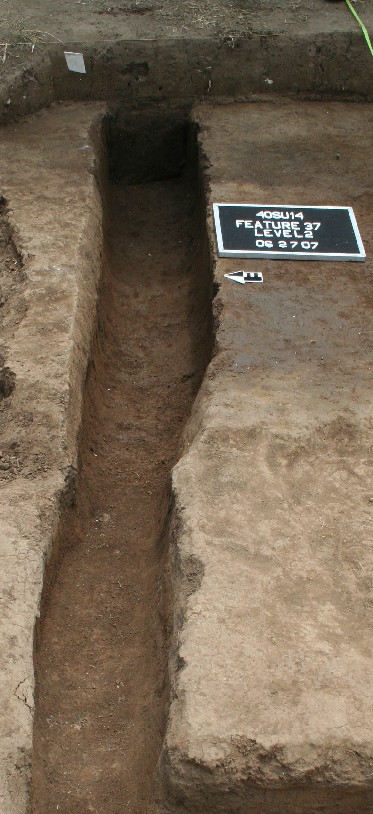

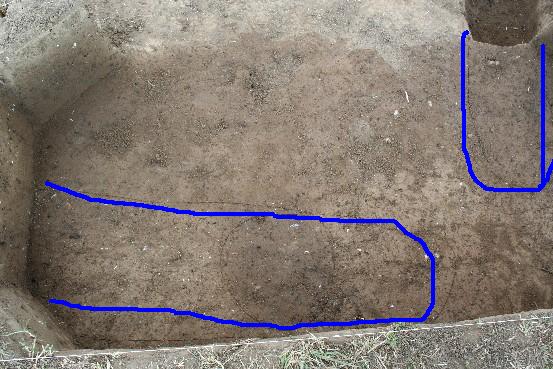
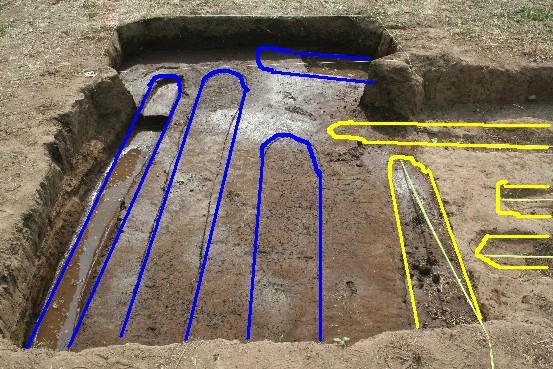



As our last fews days of the summer field project wind down, we are
staying extra busy gathering as much information as possible -- short
lunches and a lot of hard work on a 90+ day. A small thunderstorm passed through before dawn this morning. Many of
our neighbors on the property were out and about enjoying the water this
morning -- including this bunny. The milkweed is starting to bloom after the rain -- attracting all
kinds of insects including these two butterflies. And a praying mantis was wandering around the sweetpeas. Of course, the welcome rain did mean a quick chore this morning bailing
the water from our plastic... 'Twas a hot and hard-working day, so the photos and comments will be a
bit brief for tonight! In order to interpret the architecture of this
large building, we need to have a good handle on all four walls --
particularly the corners. So, we've focused on opening a few more small
excavation areas to make sure that we have a solid idea of the corners.
For the times, this was an exceptionally large building -- about the
equivalent of 1250 square feet. On the southwest corner, we opened a small 1x2 meter unit to catch the
ends of two wall trenches. In the photo below the large trench at lower
left is the last version of the west wall and the one on the right is the
last version of the south wall. Nice corner confirmed in this area. In the very end of the south wall trench (the one on the right in the
photo above), we identified a small cache of carbonized corncobs. This
appears to have been an intentional cache -- perhaps a dedicatory offering
at the time the building was erected. On the southeast corner, we excavated two adjacent 1x1 meter units to
clarify the ends of the east wall. We managed to find the ends of two of
the east wall trenches as shown below. On the north wall, we continued excavations of two of the trenches.
What we had originally identified as a single trench is now clearly two
trenches -- one with a carboned log set in the edge. In the photo below,
the arrow is pointing at the charred log set in the edge of the
trench. This is very similar to a pattern we saw last year on the south
wall... Another long day ahead for tomorrow -- although given the weather
forecast, we may be working in our lab washing artifacts for part of the
day. We'll welcome the rain.





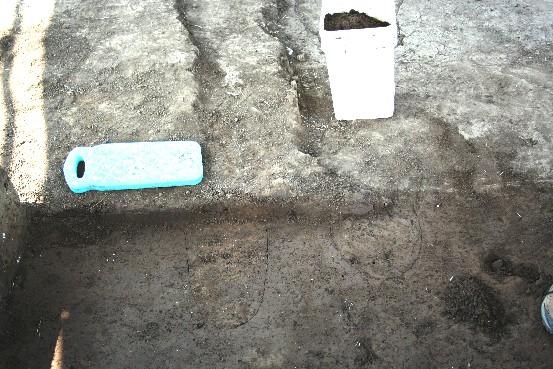
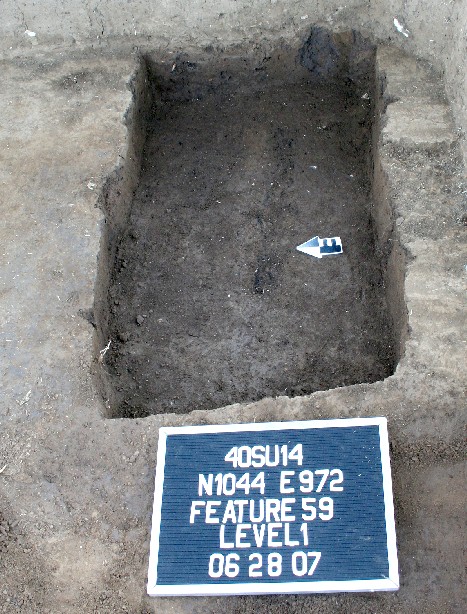

Once again, everyone was grateful for the rain last evening (although
we didn't appreciate so much the resulting humidity). As has become
our routine, bailing was the first chore of the day. Ali has
perfected the overhead water toss -- and may be a contender for an
Olympic spot. Most of the morning today was spent on cleaning up our excavation units
-- taking several of them a few centimeters deeper to see if we can better
identify the features. In this area, we identified yet another odd-shaped ash-filled feature
with the edges burned to pottery consistency. These areas around the
large pit feature are a bit difficult to interpret. They resemble natural
features -- parts of a tree stump or roots that have smoldered and created
an amorphous feature. But, the artifacts included in the ash are somewhat
puzzling -- fragments of unburned pottery within the ash for example. We
will have to ponder on these features for some time to come. Elsewhere, the crew worked stripping about ten units down to a lower
level. Larry took on the tedious and mind-numbing task of cleaning the dust
and grass out of the older excavation units. Later in the morning, my nephew Keaton dropped by to help Uncle Kevin
show the college kids how to dig properly. Thanks to the hard work today -- we were able to clear up several of
the mysteries of this structure. Having all of the excavation units
cleaned up at the same time greatly helps in interpreting the "big
picture". We've now confidently identified portions of all four corners of the
structure, most of the walls, and the central post. Over the remaining three days, we'll be excavating selected sections of
trenches and probably opening another couple of units to clarify a few
remaining questions. Soon after lunch, the promised rain began to gather on the horizon --
with several weeks of practice, we closed up quickly and efficiently and
headed to the lab for some welcome artifact washing time. While the showers and small storms passed by for the rest of the
afternoon, we washed up a few thousand artifacts in our field lab. Including this fine example of a small flint arrowpoint. More news tomorrow!





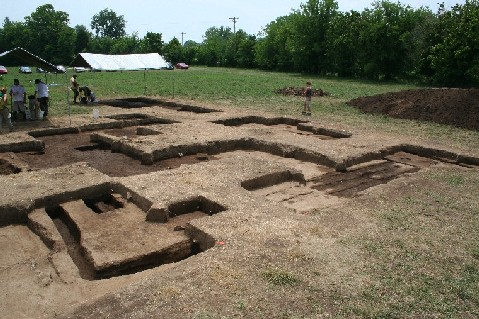




Today was the last of our Volunteer Saturdays. We had a great turnout
of students and volunteers -- and despite the heat had a great day.
Once again, the day started with bailing water from the plastic. Our thanks to the volunteers: Howie Brainerd, Jennifer Clinton, Garret
Cole, Daniel Connatser, Ellis Durham, Tony Ford and son Gregory, Ann
Funkhouser, Susan Ghorbani, Susan Jordan, Caroline Kiev, Alicja Kutyla,
Mark McKee III, and Chris and Steve Robbins. Our students and volunteers worked on excavating a variety of features
today -- including sections of wall trenches, large postholes, and a
series of small pits outside the structure. Just to the east of the wall-trench structure, we identified several
small pits today. Although our excavations did not get far enough to
begin to interpret what these pits were used for originally, they did
yield some interesting artifacts such as this handle from a medium-sized
pottery vessel. This handle should date to around A.D. 1200 or slightly before. In a
nearby pit, we uncovered another cache of carbonized corncobs. Work on the east wall trenches met with great success -- including the
identification of a large number of postmolds. And a small ash-filled posthole just outside the easternmost wall
trench. Work resumed on several of the north wall trenches. Below Lynne and
Alicja work on one of the north wall trenches while Caroline works on
another in the background. On the west wall, we continued work to identify the ends of several of
the wall trenches. Chris Robbins and his father Steve assisted in these excavations --
Steve was handy with the wheelbarrow as well. In the center of the structure, we identified another probable large
post and began excavating it. At this point, we haven't completed enough
of the feature to be certain -- but it definitely looks like a post
similar to that excavated last year. If this proves to be the case, we
probably have a series of three large posts in the center of the
structure. This posthole produced another handle from a smaller pottery vessel --
this handle should date around A.D. 1250. On the way out today, I took a quick tour around the property in an
attempt to photograph a big, camera-shy fox squirrel who's been playing
tag with me for two years now. Once again, no fox squirrel photo. But, I
did discover this beehive in an ancient cedar tree in the back forty. The students and staff are now ready for a welcome day off from the
heat and humidity. More news on Monday.


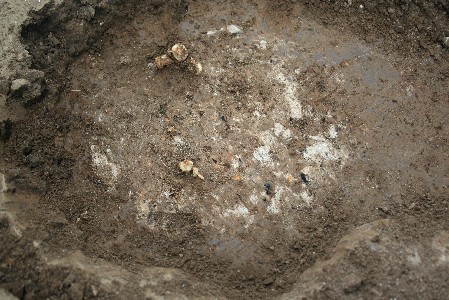






As several of us noted today -- you couldn't really ask for a better
day for archaeology than today. Not too hot, not too humid, a nice
breeze, and plenty of drifting clouds. We continued work today on so many different features and areas that
we'll save the "blow by blow" for the summary on Thursday. We did have some rather spectacular archaeological discoveries today --
two small pits packed full of carbonized corn cobs, husks, and stalks.
While not perhaps the golden treasure that most folks would think
archaeologists are looking for -- these items are truly treasures from the
past. These rare types of preserved samples of ancient corn will allow us
to study the varieties of corn, estimate productivity, and many other
aspects of daily life from A.D. 1200. The closeup below shows several of the cob segments. The small pit feature show below shows dozens of small cobs filling the
pit. Although these remains were fragile after sitting in the ground for 800
years -- we managed to retrieve dozens of whole cobs through a painstaking
all-day excavation. As our project begins to wind down, much of our remaining time will be
taken up in excavations, recording and documenting our finds --
including many dozens of photographs like that shown below. More news on Tuesday...




As our time remaining for Summer 2007 at Castalian Springs ticks away,
the entire crew is working fast and furious -- but careful -- to complete
the last excavations, complete our final records and documentation, and
begin "closing down." Among the more significant recent discoveries is the second large
central post pit. As shown below partially excavated, there are several
postholes and at least two insertion ramps visible. Although the discovery of the remains of these architectural features
is of greatest significance, the fill also contains a sample of
interesting artifacts -- including this whole deer mandible (jaw
bone). We'll be cleaning up all of our excavations and will provide a
"summary" of our accomplishments on Thursday and Friday.


